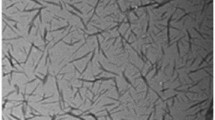Abstract
PCL/PEO copolymers with different compositions were obtained from ring opening polymerization of ε-caprolactone in the presence of ethylene oxide and characterized by various analytical techniques. Data collected from DSC and X-ray diffractometry suggested that the copolymer chains possess a blocky structure, leading to both PCL and PEO-type crystalline structures. Hydrolytic degradation of these copolymers was carried out in a pH=10.6 carbonate buffer solution at 37 °C. Comparison was made with a PCL homopolymer and a PCL/PEG blend which had the same gross composition as one of the copolymers. The results showed that the presence of PEO sequences considerably enhanced the hydrophilicity of the copolymers as compared with PCL homopolymer. Nevertheless, the degradability of PCL chains was not enhanced due to the phase separation between the two components. These materials should be of great interest for biomedical uses such as matrices for sustained drug delivery because of the presence of both hydrophilic and hydrophobic microdomains. ©2000 Kluwer Academic Publishers
Similar content being viewed by others
References
S. J. HOLLAND, B. J. TIGHE and P. L. GOULD, J.Control.Rel. 4 (1986) 155.
M. VERT, S. M. LI and H. GARREAU, J.Control.Rel. 16 (1991) 15.
R. L. DUNN in “Biomedical applications of synthetic biodegradable polymers”, edited by J.O. Hollinger (CRC Press, Boca Raton, 1995) p. 17.
S. M. LI and M. VERT, in “Degradable polymers: principles and applications”, edited by G. Scott and D. Gilead (Chapman and Hall, London, 1995) p. 43.
S. M. LI, H. GARREAU and M. VERT, J.Mater.Sci.: Mater.Med. 1 (1990) 123.
H. GARREAU and M. VERT Idem., ibid. 1 (1990) 131.
H. GARREAU and M. VERT Idem., ibid. 1 (1990) 198.
M. THEÂRIN, P. CHRISTEL, S. M. LI, H. GARREAU and M. VERT, Biomaterials 13 (1992) 594.
S. M. LI and M. VERT, Macromolecules 27 (1994) 3107.
C. G. PITT, A. R. JEFFCOAT, R. A. ZWEIDINGER and A. SCHINDLER, J.Biomed.Mater.Res. 13 (1979) 497.
C. G. PITT, in Biodegradable polymers and plastics”, edited by M. Vert, J. Feijen, A. Albertsson, G. Scott and E. Chiellini (The Royal Society of Chemistry, Cambridge, 1992) p. 1.
K. J. ZHU, X. Z. LIN and S. L. YANG, J.Appl.Polym.Sci. 39 (1990) 1.
Y. X. LI, C. VOLLAND and T. KISSEL, J.Control.Rel. 32 (1994) 121.
X. M. DenG, C. D. XIONG, L. M. CHENG and R. P. XU, J.Polym.Sci., Part C, Polym.Lett. 28 (1990) 411.
Z. JEDLINSKI, P. KURCOK, W. WALACH, H. JANECZEK and I. RADECKA, Makromol.Chem. 194 (1993) 1681.
H. YOUNES and D. COHN, J.Biomed.Mater.Res. 21 (1987) 1301.
P. CERRAI, M. TRICOLI, L. LELLI, G. D. GUERRA, R. SBARBATI DEL GUERRA, M. G. CASONE and P. GIUSTI, J.Mater Sci.: Mater.Med. 5 (1994) 308.
I. RASHKOV, N. MANOLOVA, S. M. LI, J. L. ESPARTERO and M. VERT, Macromolecules 29 (1995) 50.
S. M. LI, I. RASHKOV, J. L. ESPARTERO, N. MANOLOVA and M. VERT, ibid. 29 (1995) 57.
S. G. WANG and B. QIU, Polymers for Advanced Technologies 4 (1993) 363.
D. A. HEROLD, K. KEIL and D. E. BRUNS, Biochem.Pharmacol. 38 (1989) 73.
A. W. RICHTER and E. AKERBLOM, Int.Arch.Allergy Appl.Immunol. 70 (1983) 124.
J. M. HARRI S, J.Macromol.Sci.Rev.Macromol.Chem.Phys. C25 (1985) 325.
S. ZALIPSKY, C. GILON and A. ZILKHA, Eur.Polym.J. 19 (1983) 1177.
N. MANOLOVA, V. BARANOVSKY, I. RASHKOV and V. MAXIMOVA, ibid. 29 (1993) 721.
T. PETROVA, N. MANOLOVA, I. RASHKOV, S. M. LI and M. VERT, Polym.Inter. 45 (1998) 419.
S. M. LI, H. GARREAU, M. VERT, T. PETROVA, N. MANOLOVA and I. RASHKOV, J.Appl.Polym.Sci. 68 (1998) 989.
X. H. CHEN, S. P. MCCARTHY and R. A. GROSS, to be published.
D. R. PAUL in “Polymer blends” (Academic Press, New York, 1978) p. 56.
Author information
Authors and Affiliations
Rights and permissions
About this article
Cite this article
Li, S.M., Chen, X.H., Gross, R.A. et al. Hydrolytic degradation of PCL/PEO copolymers in alkaline media. Journal of Materials Science: Materials in Medicine 11, 227–233 (2000). https://doi.org/10.1023/A:1008920326988
Issue Date:
DOI: https://doi.org/10.1023/A:1008920326988




